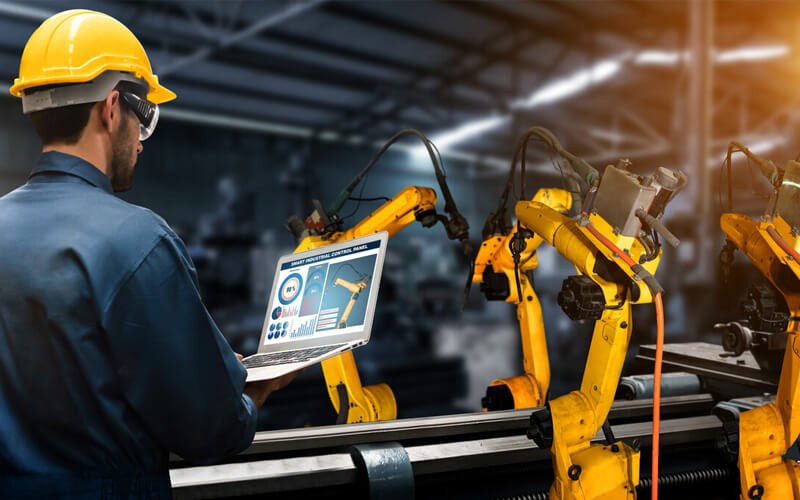
The Industrial Internet of Things (IIoT) converges physical hardware with software-driven intelligence to deliver transformative applications for the cyber-physical world. Manufacturing is a significant benefactor of this digital transformation. IIoT applications for manufacturing encompass monitoring and optimizing equipment performance, quality control, human-to-machine interaction and more.
A McKinsey research report predicts by 2030, the net improvements in smart manufacturing efficiency could be worth up to $12.6 trillion globally. IIoT applications involving sensing, connectivity and data analytics that demand highly reliable hardware and software components are central to this prediction.
A Roundup of Industrial IoT Applications Transforming Manufacturing
IIoT applications for manufacturing essentially bring together “siloed” data within functional areas such as production, operations, maintenance and quality control under one umbrella.
Monitoring-Based Quality Control
Process monitoring applications collect and analyze sensor data in real-time, providing better efficiencies at three levels:
- At the machine level, pre-programmed parameters are monitored and adjusted automatically when there’s a shift in range.
- At the production level, machine data collected over multiple runs helps adjust the formulation or design of the product to address quality gaps proactively. For analyzing complex product functionality, factories can utilize “digital twins,” where a virtual representation of the product is monitored and analyzed across its entire life cycle to incorporate design changes.
- At the implementation level, OEMs can utilize customer input to directly program into different iterations or adjustments to the product.
Unlike traditional “after-the-fact” quality management, plant managers can now proactively manage quality. Quality control, which used to be a “last defense” necessity with high overhead costs, is getting integrated at all stages of production, enabling significant cost savings.
Predictive Maintenance
Low-cost wireless connectivity and digitization in smart factories have made IIoT-based predictive maintenance (PdM) a reality in manufacturing plants. A study shows that PdM increases uptime by 10 to 20 percent while reducing maintenance costs by 5 to 10 percent and maintenance planning time by 20 to 50 percent. IIoT-based PdM is enabling many success stories. The Volvo Group, for example, reduced diagnostic times of their fleet by up to 70 percent and repair times by 20 percent by accurately predicting defects in gearing and motor equipment.
According to Deloitte, by 2025, PdM applications are expected to reduce factory equipment maintenance costs by 40 percent while generating an economic value of $630 billion annually.
IoT Asset Tracking
IIoT asset tracking helps manufacturers bridge the gaps and inefficiencies of inventory management. IoT asset tracking leverages sensor data and cloud services to provide visibility into asset location, condition and usage to precisely track assets and plan maintenance windows. Factory staff can monitor assets and machinery on the shop floor using a combination of technologies, like radio frequency identification (RFID), wearables and mobile systems to make decentralized decisions. The resulting administrative cost savings can add up to 1.9 trillion USD over the next decade.
Digital Supply Chain
The digital supply chain is another IIoT application that provides manufacturers visibility into the entire supply chain from production to delivery. This visibility is crucial to optimize production and safeguard goods in transit, improving customer service and process efficiencies.
A smart supply chain uses connected sensors to close the control loop with real-time asset monitoring throughout the chain. Sensors assess various asset status variables like temperature and vibration that may affect raw goods and materials quality.
Hardware Considerations for IoT System Design
Advances in sensor design and fabrication technologies, as well as low-cost connectivity options like low-power wide area networks (LPWAN), enable the adoption of IIoT applications in manufacturing. While the software is integral to these applications, hardware design is no less a crucial component for making IIoT effective.
The sensor design is central to these applications since sensors feed the raw data, which are subsequently processed, analyzed and presented for better decision-making. Sensors in manufacturing applications like unmanned vehicles and drones must be rugged to withstand adverse conditions while delivering data. In addition to PCB circuits, ground planning and signal integrity, system designers should carefully consider the parameters for battery-powered sensors.
In battery-powered sensor design, every milliamp crossing the circuitry affects battery lifespan. The sensors are often resource-constrained with limited real estate but need room to house wireless transceivers that transmit data to the host controller. Advanced PCB design tools can help designers address electromagnetic interference (EMI) and signal integrity challenges. Designers can leverage good analysis and layout tools to work through these challenges of implementing IoT in manufacturing environments.
Another prominent challenge when implementing IoT is the reliability of the components and integrity of the data from the sensors and aggregation nodes. Manufacturers and system designers must navigate the emerging threat of counterfeits and unreliable parts by sourcing components from vetted suppliers like TTI.
Conclusion
The smart manufacturing industry is poised to grow from $250 billion in 2021 to $658 billion in 2029. A big part of this growth depends on building highly reliable IIoT applications. Hardware and software design integrity will be crucial in making this happen.
Sravani Bhattacharjee has worked as a tech leader at Cisco, Honeywell and other companies where she delivered many successful innovations to the market. As the principal of Irecamedia, she collaborates with Industrial IoT innovators to create compelling vision, strategy and content that drives awareness and business decisions.
Follow TTI, Inc. on LinkedIn for more news and market insights.
Statements of fact and opinions expressed in posts by contributors are the responsibility of the authors alone and do not imply an opinion of the officers or the representatives of TTI, Inc. or the TTI Family of Specialists.

